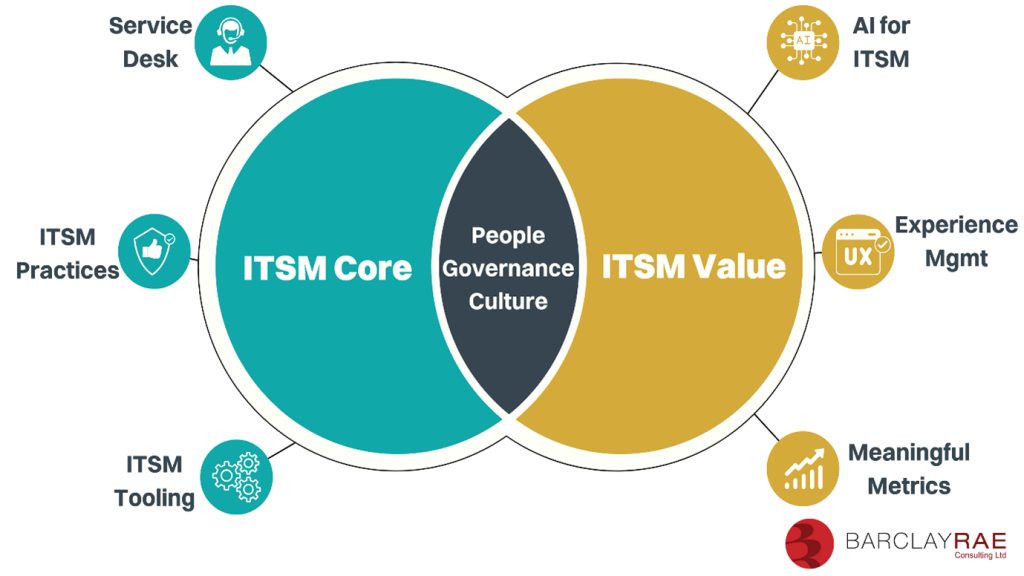Many organizations continue to struggle to achieve the desired outcomes from IT service management (ITSM). Tools and processes have been around for decades, but they are often viewed as the solution in themselves rather than as enablers of business value. To achieve real success, we need to understand how ITSM creates value for the business and make sure our approach reflects that.
That balance is captured in this picture: Core, Value, and Enablers.

The elevator pitch here is that:
- The ITSM Core elements are your foundations and established practices. The established, long-lasting methods and systems that are the foundation for building service management strategies.
- The ITSM Value elements include innovations such as artificial intelligence (AI), experience management, and data analytics. These are new, impactful tools and concepts that enhance efficiency and user experience.
But we mustn’t overlook the overlap of this Venn diagram – the enablers.
Enablers for service management success
I bet most, if not all, of the ITSM Core and ITSM Value elements are on your organization’s radar. But what about the enablers?
Again, let’s start with an elevator pitch of what the enablers are:
- People
- Governance
- Culture.
These are “unchanging” elements that are essential in strategy, roles, culture, and social responsibility. Importantly, the focus is on organizations and goals, not just creating tools, with experience, knowledge, and ongoing learning essential.
I’d argue that these elements are the starting point for service management success rather than moving from the left to the right of my diagram. For example, ITSM professionals must recognize that governance – “the means by which an organisation is directed and controlled” – is something that everyone has a role to play in, either in terms of monitoring and tracking and adjusting, or simply by being aware of what the agreed levels are.
Issues with these enablers will ultimately adversely affect the success of your service management capabilities. But what’s key with ITSM Core and ITSM Value?
ITSM Core elements in more detail
Let’s return to the service desk, ITSM practices, and ITSM tools.
Think of the service desk as your flagship – it’s the “face” of service. It must evolve into a new role – from break-fix to innovation hub. It’s also a key entry point and career builder in your organization, playing a pivotal role in employee growth and knowledge sharing. It is also key to value-add stakeholder management.
Your ITSM (and potentially enterprise service management (ESM)) practices should go beyond the basics of incident, problem, and change management fundamentals, expanding to service catalog, portfolio, and demand management. The importance of change, problem, and demand management to service management success shouldn’t be overlooked. The ITIL management practices that relate to these areas are foundational, yet evolving tools.
The ITSM tools market is currently undergoing a period of rapid evolution, but we shouldn’t forget that we’ve had 30+ years of ITSM tools supporting service management. For me, their success depends on their strategic alignment with business needs. For example, their effective use requires a strategic view that includes a target operating model (TOM), agreed strategy, and data readiness. While common pitfalls often include underuse and misuse, as well as a lack of strategic planning. Ultimately, the key to success is tied to aligning ITSM tools with the aforementioned enablers.
This is also where Digital Employee Experience (DEX) comes in, giving IT teams actionable insight into how technology impacts employees day to day and enabling improvements that go beyond systems into the way people actually work.
ITSM Value elements in more detail
This is where “the rubber hits the road” in terms of service management making a difference to business operations and outcomes. As shown on the earlier diagram, AI (and automation), experience management, and meaningful metrics (data analysis) are critical to bringing the enablers and the ITSM Core elements to the required position of business value creation (or cocreation).
Think of AI as a business enabler, not just a replacement. As with all technology, risk assessment and human impact remain essential. For example, while real-world applications of AI include speeding up and optimizing ITSM processes, it’s critical to balance AI use in the context of risk assessment and the human impact.
Experience management involves moving beyond service level agreements (SLAs) to experience level agreements (XLAs). IT involves capturing feedback from multiple sources and using this to improve and meet business expectations, fix issues, and engage positively with your stakeholders. DEX tools make this practical, providing real-time insight into how employees experience technology and enabling IT to act on issues before they escalate. If it helps, think of experience management as an evolution of traditional service levels that requires actionable data to drive meaningful change. XLA engagement also drives relationships. However, remember that while experience management highlights issues (and opportunities), it still requires action.
Data analysis for insight is the backbone of value creation. The old IT(SM) metrics are no longer enough for your IT department to remain relevant. C-level executives demand demonstrated value, and existing legacy IT metrics don’t deliver this. Metrics must reflect a rounded view – a bundle of different types of data that covers:
- Performance
- Experience – sentiment and digital
- Outcomes – business activities, risks, and costs
- Innovation – business, technical, and individual
It’s therefore important to capture relevant data for analysis, and AI should be leveraged to gain insights.
Enablers again
Given their importance to service management success, it would be remiss not to mention them again in finishing this blog.
People, governance, and culture:
- Are the heart of service management success
- Shape implementations
- Are essential elements for sustainable transformations.
ITSM success: from principles to practice
Delivering service management success isn’t about ticking off processes or chasing every new tool. It’s about keeping ITSM practical, human, and focused on outcomes. That’s the essence of the ITSM Goodness approach, simple to understand, inclusive, and proven to deliver results.
ITSM Goodness encourages us to engage with customers, define services in business terms, and make the service desk a genuine flagship. It reminds us that people, governance, and culture are not afterthoughts but the foundation for sustainable success.
And when it comes to experience management, DEX provides one of the most practical ways to act on feedback. By transitioning from SLAs to XLAs and capturing real user experience data, organizations can implement changes that directly enhance both productivity and satisfaction.
Success comes from combining Core practices, new Value drivers, and the Enablers that hold them together, applied through an ITSM Goodness mindset.
If you think your organisation would benefit from a service management health check, find out more about the service we offer here.




